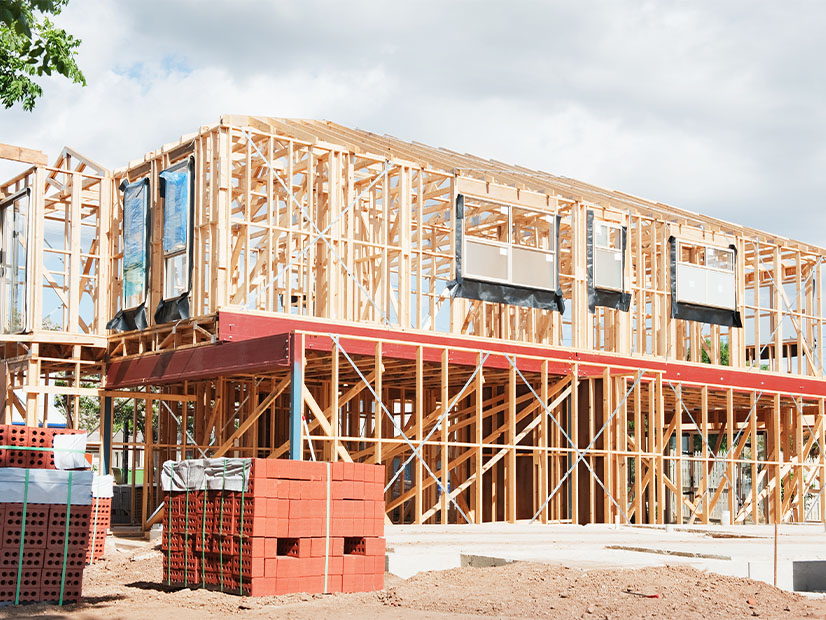
Clean energy transition nonprofit Rocky Mountain Institute on Nov. 14 kicked off a “soft launch” of HomebuildersCAN, a new network to accelerate decarbonization of the residential construction sector.
The industry stakeholder group, which launches fully in January 2024, will bring together homebuilders of all sizes to lower the embodied carbon in new homes and improve reporting of Scope 3 greenhouse gas emissions — indirect emissions in a company’s supply-chain.
“We have three overarching goals with HomebuildersCAN. One is to increase performance on embodied emissions for new homes, figuring out where we are today and how do we map to zero as quickly as possible,” said Chris Magwood, an embodied carbon and residential construction expert at RMI (founded as Rocky Mountain Institute) overseeing the initiative.
“Our second goal is to bring alignment across the sector so that builders are approaching this the same way. Finally, for the homebuilders themselves, we want to be supporting and encouraging them to adopt and scale profitable climate smart building practices,” he said.
Along with improving the practices and reporting within the industry, the initiative aims to bring a shared and cohesive approach to embodied carbon to the wider ecosystem of regulators, lenders, energy efficiency programs and others, Magwood said.
HomebuildersCAN will help builders learn about embodied carbon and develop the capacity to incorporate embodied carbon reductions into strategic plans and reports, Magwood said.
“What we don’t want this organization to be is another labeling program, so we’re not looking to get into the business of certifying homes. We want to support homebuilders in tackling embodied carbon issues in their practice,” he said.
The Climate Action Network (CAN) for homebuilders’ goals span from education to advocacy, and it will provide a standardized table for consistent reporting at an individual building, community or portfolio level. The industry already has several green building standards such as LEED, Passive House and HERS, and HomebuildersCAN’s reports are intended to be complementary and reference existing programs where used. A proposed annual reporting template will help companies report their impact as a whole.
The group will help homebuilders include carbon reduction in their strategic plans, Magwood said.
“Once the program is up and running in 2024, we’ll be working with the builders to help them get on to an embodied carbon reduction pathway. That’s going to start by providing a lot of assistance to benchmark where their embodied carbon emissions are right now and then help institute a five-year plan,” he said.
Inaction on Climate Change as the Biggest Competitor
Several North American homebuilders joined HomebuildersCAN prior to its official launch and shaped the reporting tools and other program features.
“We don’t see our builder down the street as our competitor anymore. We see inaction on climate change as our biggest competitor,” said Phil Squires, corporate vice president of sustainability and procurement at Mattamy Homes, the largest privately owned homebuilder in North America. “We all face the same challenges regarding design, supply, execution, tracking data and, ultimately, affordability.”
While the homebuilding industry has taken large strides toward improving home energy efficiency over the last few decades, Squires said, dealing with embodied carbon is relatively new and there is urgency in understanding and driving down that embodied carbon.
“We see our homes today as carbon sources and through partnerships like HomebuildersCAN, we’re hoping that we can turn that into carbon sinks,” he said.
The creation of HomebuildersCAN was prompted in part by local governments adopting climate action plans, said Aaron Smith, CEO of the Energy and Environmental Building Alliance (EEBA).
“One of the studies we did said that most builders didn’t know it was good to have less carbon in their home,” said Smith. HomebuildersCAN will help educate those builders about why there’s a need to reduce embodied carbon in homes and how they can reduce it.
Part of the challenge for homebuilders, Smith said, is that many products do not have Environmental Product Declarations (EPD), a declaration of the carbon embodied in a material, making it impossible for the builders to accurately measure the embodied carbon footprint of the homes they build.
The initiative will encourage the use of the Embodied Carbon in Construction Calculator (EC3) developed by Stacy Smedley of Skanska and Phil Northcott of C Change Labs and integrated into two existing Carbon Action Networks focused on the global building industry: OwnersCAN and MaterialsCAN.
